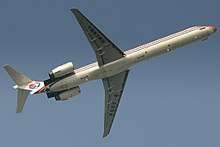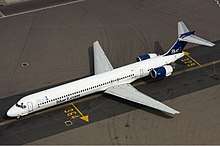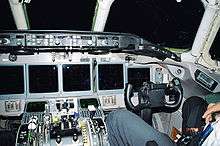McDonnell Douglas MD-90
| MD-90 | |
|---|---|
| Japan Airlines MD-90-30 on final approach at Tokyo Haneda Airport | |
| Role | Narrow-body jet airliner |
| National origin | United States |
| Manufacturer | McDonnell Douglas Boeing Commercial Airplanes |
| First flight | February 22, 1993 |
| Introduction | 1995 with Delta Air Lines |
| Status | In service |
| Primary users | Delta Air Lines Saudi Arabian Airlines (historical) Japan Airlines (historical) EVA Air (historical) |
| Produced | 1993–2000 |
| Number built | 116[1] |
| Unit cost |
US$41.5–48.5 million |
| Developed from | McDonnell Douglas MD-80 |
| Variants | McDonnell Douglas MD-94X |
The McDonnell Douglas MD-90 is a twin-engine, short- to medium-range, single-aisle commercial jet airliner. The MD-90 was developed from the MD-80 series. Differences from the MD-80 include more fuel-efficient International Aero Engines V2500 engines and a longer fuselage. The MD-90 has a seating capacity of up to 172 passengers and was introduced into service with Delta Air Lines in 1995.
The MD-90 and the subsequent MD-95/Boeing 717 were derivatives of the MD-80, which itself was commercially introduced in 1980 as a derivative of the DC-9.
Design and development
Background
The Douglas Aircraft Company developed the DC-9 in the 1960s as a short-range companion to their larger DC-8.[2] The DC-9 was an all-new design, using two rear fuselage-mounted turbofan engines, and a T-tail. The DC-9 has a narrow-body fuselage design with a 5-abreast seating with a capacity of 80 to 135 passengers depending on seating arrangement and aircraft version.
The second generation of the DC-9 was originally called the DC-9-80 series or the DC-9 Super 80 but later marketed as the MD-80[3] and entered service in 1980. McDonnell Douglas began studies into shorter derivatives of the MD-80 in 1983, these studies eventually becoming known as the MD-90. While for several years, McDonnell Douglas proposed powering the MD-90 with two propfan engines, by 1989, it was clear that there was insufficient interest in prop fan powered aircraft, and reworked their proposals to feature the IAE V2500 turbofan instead.[4]
MD-90
The MD-90 was firmly launched on November 14, 1989, when Delta Air Lines placed an order for 50 MD-90s, with options for a further 110 aircraft.[4] The aircraft first flew on February 22, 1993 and the first MD-90 was delivered to Delta in February 1995.[5] The MD-90 was produced adjacent to the Long Beach Airport in Long Beach, California, USA.

The MD-90 is a mid-size, medium-range airliner that was developed from the MD-80 series. It is a 5-foot-longer (1.5 m), updated version of the MD-88 with similar electronic flight instrument system (EFIS) and more powerful, quieter and fuel efficient IAE V2500 engines instead of the JT8D engines, which power the MD-80 series. This made the MD-90 the first derivative variant of the DC-9 to use a high-bypass turbofan engine. Due to the heavier engines, the pylons holding the engines featured flaps that deflect 30° downward to assist in pitching down for stall recovery. The system activates automatically when the control column is pushed fully forward.[6]
Typical seating for the MD-90 ranges from 153 to 172 passengers, depending on the cabin configuration and interior layout.[7] The MD-90 was produced in two versions: -30 and -30ER. The -30 has a range of 2,400 miles (3,860 km). The -30ER has a higher gross weight and range up to 2,750 miles (4,426 km) with an auxiliary fuel tank. An even longer range version, the -50, was offered but was never ordered.[8]
The initial MD-90s feature an EFIS cockpit similar to the MD-88's cockpit.[9] The 29 MD-90s delivered to Saudi Arabian Airlines feature a full glass cockpit with avionics and an overhead display panel similar to the MD-11's cockpit for easy transition for the airline's pilots of the MD-11, also operated by the airline.[9][10]

No MD-90 orders were received after Boeing and McDonnell Douglas merged in 1997 due to internal competition with Boeing's 737.[11] Delta Air Lines had initially placed a large order for the MD-90 to replace some aging Boeing 727s. After the Boeing-McDonnell Douglas merger, Delta canceled their remaining 19 MD-90 orders in favor of the Boeing 737-800.[11][12] A total of 40 MD-90s (later 20) were to be assembled under contract in Shanghai, People's Republic of China under the Trunkliner program,[13][14] but Boeing's decision to phase out the MD-90 resulted in only two built by Shanghai Aircraft.[15]
MD-90 production at Long Beach, California ended in 2000 with the last airplane being delivered to Saudi Arabian Airlines,[11] and MD-90T production at Shanghai ended in 2000. With 116 MD-90 aircraft produced, the MD-90 production run was the smallest among the DC-9 family.[1] Two aircraft were also produced at Jiangwan Airfield in Shanghai, People's Republic of China.[16]
Following the MD-90 in the DC-9 family was the MD-95, which was renamed the Boeing 717-200 after McDonnell Douglas (successor to Douglas Aircraft Company) merged with Boeing in 1997.[17] The main competitors of the MD-90 included the Airbus A320 and the Boeing 737-800.
Variants
- MD-90-30
- Base variant with two V2525-D5 engines and an EFIS cockpit similar to that of the MD-88. This engine also has an option to add 3,000lbf for use in Hot & High conditions if needed by activating a switch in the flight deck.
- MD-90-30IGW
- Increased Gross Weight version, one built.
- MD-90-30ER
- Extended Range (ER) version of MD-90-30, two built.
- MD-90-30T "Trunkliner"
- Variant of the MD-90-30 assembled by Shanghai Aviation Industrial Corporation in the People's Republic of China. Production was initially planned to be 40,[18] later reduced to 20,[19] with only two built in the end.[20] To accommodate the heavy aircraft on unsuitable runways, a dual tandem landing gear with more tires to spread the weight of the aircraft was designed for the Trunkliner,[21] but ultimately not used in the two aircraft produced.[22] The Comac ARJ21 is built using tooling retained by the Chinese after the end of the Chinese MD-90-30 program.[23]
- MD-90-30EFD
- Enhanced Flight Deck version of MD-90 with the same cockpit as MD-95/B717 and MD-11, 28 built.
- MD-90-50ER
- A proposed variant with increased MTOW, and up-rated IAE V2528-D5 engines with 28,000 lbf thrust (engines up-rated via software upgrades to FADEC).
Operators
As of July 2018, Delta Air Lines is the sole remaining operator with 53 in service.[24]
Accidents and incidents
As of May 2018, the MD-90 has been involved in three incidents,[25] including one hull-loss accident,[26] with 1 fatality.[27]
- Notable accidents and incidents
- On August 24, 1999, a UNI Air MD-90 caught fire after a passenger's carry-on luggage containing gasoline was ignited by a motorcycle battery contained in another passenger's carry-on luggage. 28 people were injured with one fatality as a result of the cabin fire. The aircraft was damaged beyond economic repair.[28][29]
Specifications


| 2 class seats | 153-158 : 12J@36" + 141/146Y@31-33" |
|---|---|
| 1 class seats | 163-172Y@29-33" |
| Cargo | 1,300 ft³ / 36.8 m³, ER: 1,177 ft³ / 33.3 m³ |
| Length | 152.6 ft / 46.51 m |
| Fuselage height | 142 in / 361 cm[31] |
| Fuselage width | 131.6 in / 334.2 cm |
| Wing span | 107.8 ft / 32.86 m |
| Height | 30.6 ft / 9.33 m |
| MTOW | 156,000 lb / 70,760 kg, ER: 166,000 lb / 75,296 kg |
| Empty weight | 88,200 lb / 40,007 kg, ER: 88,400 lb / 40,098 kg[lower-alpha 1] |
| Max payload | 41800 lb / 18960 kg, ER: 43600 lb / 19776 kg |
| Fuel Capacity | 39,128 lb / 17,748 kg[lower-alpha 2] |
| Turbofans (2 x) | 25,000 lbf (111.21 kN) IAE V2525-D5[lower-alpha 3] |
| VMO | Mach 0.84 (506 kn; 937 km/h) at 27,240 ft (8,300 m)[32] |
| Cruise | Mach 0.74, 438 kn (811 km/h) at 34,800 ft (10,600 m)[33] |
| Ceiling | 37,000 ft (11,000 m)[32] |
| Range, 153 pax | 2,045 nmi / 3,787 km, ER: 2,237 nmi / 4,143 km [lower-alpha 4] |
| Takeoff | 7000 ft / 2,100 m at 156,000 lb, ISA, SL[31] |
See also
Related development
Aircraft of comparable role, configuration and era
Related lists
References
- 1 2 "Boeing: Commercial - Orders & Deliveries". Boeing. Retrieved 27 July 2015.
- ↑ Norris, Guy and Wagner, Mark. Douglas Jetliners. MBI Publishing, 1999. ISBN 0-7603-0676-1.
- ↑ History - Chronology - 1977-1982 Archived March 6, 2012, at the Wayback Machine.. The Boeing Company. Retrieved 2007-12-14.
- 1 2 Swanborough 1993, p.90.
- ↑ "Boeing: Commercial Airplanes - MD-90 Background". Archived from the original on 2013-02-16. Retrieved 16 July 2015.
- ↑ "Powerfully quiet" (PDF). Flight International. 26 October - 1 November, 1994: 37.
- ↑ "Boeing: Commercial Airplanes - MD-90 Technical Characteristics". Archived from the original on 2013-03-08. Retrieved 16 July 2015.
- ↑ MD-90 page, airliners.net. Retrieved 2008-12-08. Archived 2008-03-11 at the Wayback Machine.
- 1 2 Becher 2002, p. 105.
- ↑ Saudia Calls for Honeywell Flat Panel Cockpit Displays for New MD-90s Archived 2008-07-27 at the Wayback Machine.. Honeywell. February 6, 1996. Retrieved: 2008-12-08.
- 1 2 3 Becher 2002, pp. 102-105.
- ↑ Delta's 1997 Annual Report, Delta Air Lines. Retrieved 2008-12-08.
- ↑ China Northern Airlines Receives First MD-90 Aircraft, The Boeing Company. Retrieved 2008-12-08. Archived 2008-04-18 at the Wayback Machine.
- ↑ "Cox Report - May 25, 1999". cnn.com.
- ↑ Boeing in China, The Boeing Company. Retrieved 2008-12-08. Archived 2008-10-20 at the Wayback Machine.
- ↑ Shanghai Jiangwan Airfield. Global Security. Retrieved: 2008-12-09.
- ↑ Boeing Chronology, 1997-2001 Archived January 2, 2013, at the Wayback Machine., Boeing
- ↑ Mintz, J., Sale of Aircraft Machinery to China Shows Perils of Exporting Technology, Washington Post, June 7, 1998. Retrieved 2008-12-09.
- ↑ China Northern Airlines Receives First MD-90, McDonnell Douglas Corporation, July 26, 1996. Retrieved 2008-12-09.
- ↑ Becher 2002, p. 104.
- ↑ Bailey, J., "China: Boeing argues MDC lead". Flight International, May 1–7, 1991. Retrieved 2008-12-09.
- ↑ "Boeing MD-90/90". Forecast International. Retrieved 2008-12-09. Archived February 26, 2009, at the Wayback Machine.
- ↑ Burchell, Bill. "Setting Up Support For Future Regional Jets". Aviation Week, October 13, 2010.
- ↑ "World Airline Census 2018". Flightglobal.com. Retrieved 2018-08-26.
- ↑ McDonnell Douglas MD-90 incidents. Aviation-Safety.net, May 25, 2018.
- ↑ McDonnell Douglas MD-90 Accident summary. Aviation-Safety.net, May 25, 2018.
- ↑ McDonnell Douglas MD-90 Accident Statistics. Aviation-Safety.net, May 25, 2018.
- ↑ MD-90 UNI Air accident on August 24, 1999. Aviation-Safety.net. Retrieved: August 9, 2010.
- ↑ "Accident Investigation Report UIA 873, B-17912MD-90-30 cabin explosion and fire during landing roll Hua-Lien, Taiwan" (PDF). August 24, 2000. Archived (PDF) from the original on August 14, 2014. Retrieved August 14, 2014.
- ↑ "MD-90" (PDF). Startup. Boeing. June 1, 2007.
- 1 2 "MD-90-30 airplane characteristics for airport planning" (PDF). Boeing. Oct 2002.
- 1 2 "Type Certificate Data Sheet" (PDF). FAA. March 25, 2014.
- ↑ John Bailey (6 December 1989). "Douglas uses MD-80 to speed MD-90". Flight International.
- Becher, Thomas. Douglas Twinjets, DC-9, MD-80, MD-90 and Boeing 717. The Crowood Press, 2002. ISBN 1-86126-446-1.
- Swanborough, Gordon. "A 'Ninety for the 'Nineties". Air International, August 1993, Vol 45 No 2. Stamford, UK:Key Publishing. pp. 90–95
External links
| Wikimedia Commons has media related to McDonnell Douglas MD-80/MD-90. |
Douglas and McDonnell Douglas aircraft production timeline, 1950-2006 | ||||||||||||||||||||||||||||||||||||||||||||||||||||||||||||
|---|---|---|---|---|---|---|---|---|---|---|---|---|---|---|---|---|---|---|---|---|---|---|---|---|---|---|---|---|---|---|---|---|---|---|---|---|---|---|---|---|---|---|---|---|---|---|---|---|---|---|---|---|---|---|---|---|---|---|---|---|
| 1950s | 1960s | 1970s | 1980s | 1990s | 2000s | |||||||||||||||||||||||||||||||||||||||||||||||||||||||
| 0 | 1 | 2 | 3 | 4 | 5 | 6 | 7 | 8 | 9 | 0 | 1 | 2 | 3 | 4 | 5 | 6 | 7 | 8 | 9 | 0 | 1 | 2 | 3 | 4 | 5 | 6 | 7 | 8 | 9 | 0 | 1 | 2 | 3 | 4 | 5 | 6 | 7 | 8 | 9 | 0 | 1 | 2 | 3 | 4 | 5 | 6 | 7 | 8 | 9 | 0 | 1 | 2 | 3 | 4 | 5 | 6 | 7 | 8 | 9 | |
| Douglas DC-6 | ||||||||||||||||||||||||||||||||||||||||||||||||||||||||||||
| DC-7 | ||||||||||||||||||||||||||||||||||||||||||||||||||||||||||||
| Douglas DC-8 | ||||||||||||||||||||||||||||||||||||||||||||||||||||||||||||
| McDonnell Douglas DC-9 | ||||||||||||||||||||||||||||||||||||||||||||||||||||||||||||
| McDonnell Douglas MD-80 | ||||||||||||||||||||||||||||||||||||||||||||||||||||||||||||
| MDD MD-90 | ||||||||||||||||||||||||||||||||||||||||||||||||||||||||||||
| MD-95 / B717 | ||||||||||||||||||||||||||||||||||||||||||||||||||||||||||||
| McDonnell Douglas DC-10 | MD-11 | |||||||||||||||||||||||||||||||||||||||||||||||||||||||||||
| = Piston-engined | = Narrow-body jet | = Wide-body jet | ||||||||||||||||||||||||||||||||||||||||||||||||||||||||||